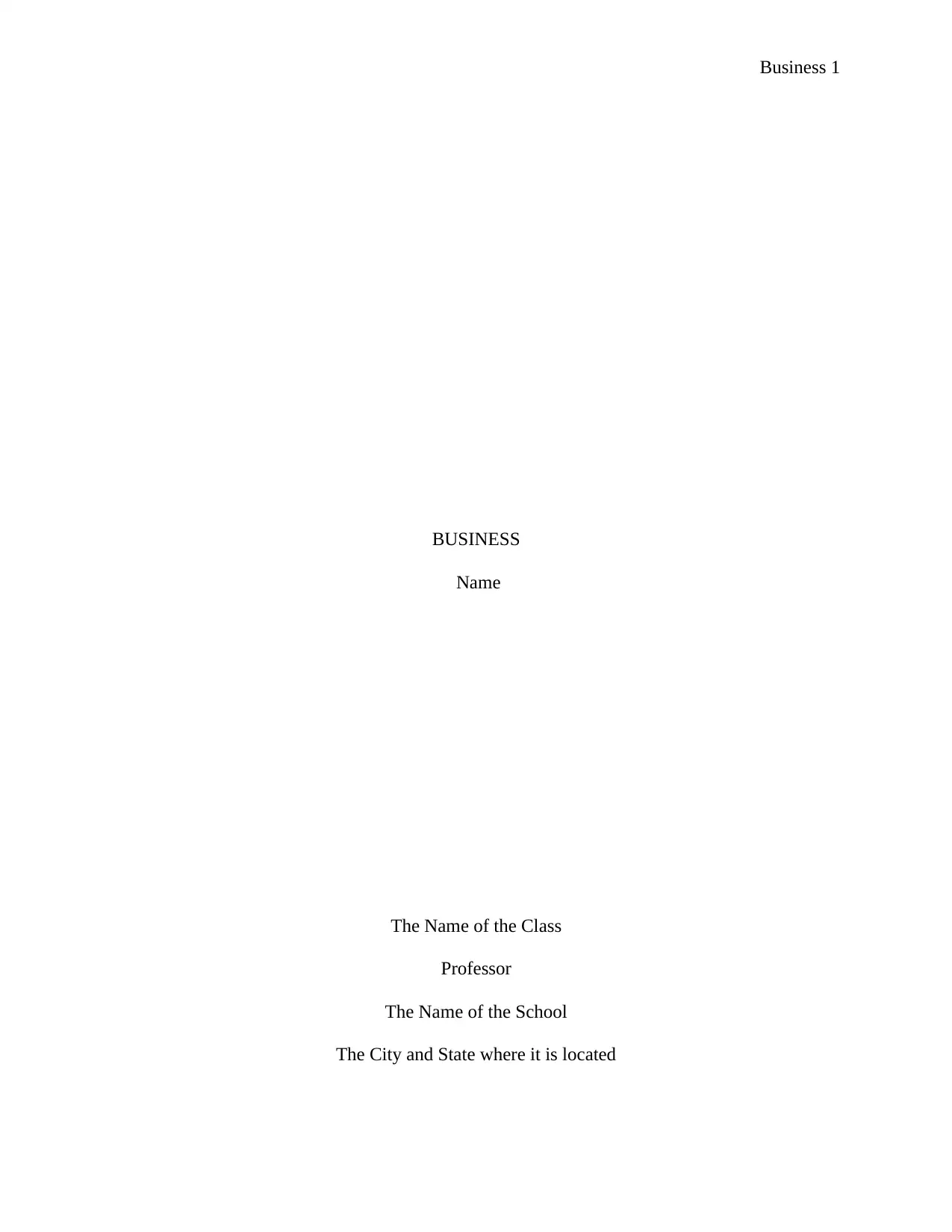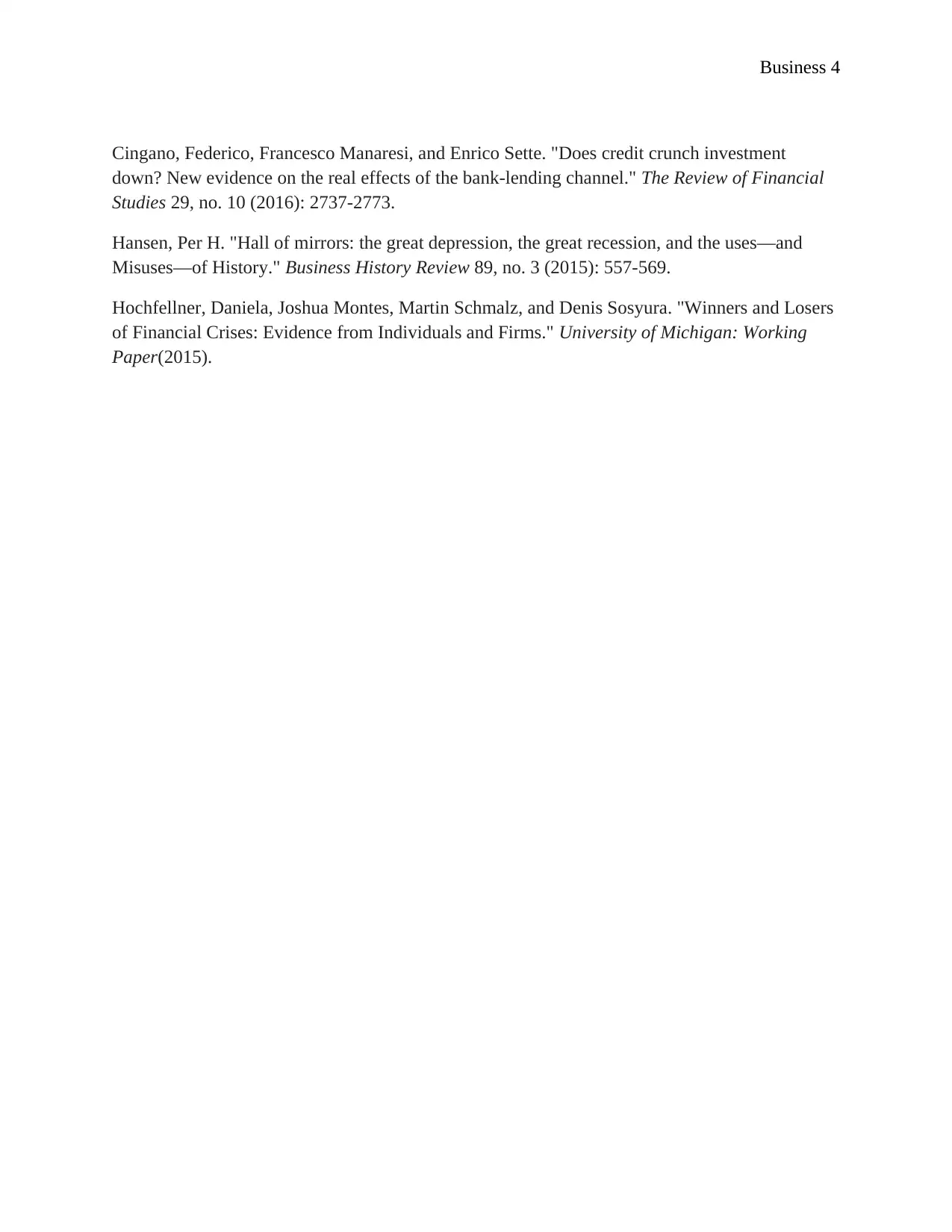Business Assignment: Recession, Depression, and Credit Crunch Analysis
VerifiedAdded on 2020/04/07
|4
|987
|262
Homework Assignment
AI Summary
This business assignment examines the concepts of recession and depression, differentiating them based on the duration and severity of economic decline. It explores the impact of the global credit crunch, detailing its effects on the United Kingdom, including bank closures, increased unemployment, and reduced spending. The assignment further analyzes the ripple effects of the credit crunch, such as reduced borrowing, decreased consumer spending, and government financial struggles. Finally, it identifies business winners during the crisis, highlighting the success of low-end retailers and low-cost airlines, contrasting them with the struggles of high-end businesses. The assignment is supported by cited sources, providing a comprehensive overview of the economic phenomena.

Business 1
BUSINESS
Name
The Name of the Class
Professor
The Name of the School
The City and State where it is located
BUSINESS
Name
The Name of the Class
Professor
The Name of the School
The City and State where it is located
Paraphrase This Document
Need a fresh take? Get an instant paraphrase of this document with our AI Paraphraser

Business 2
Business
Question 1
Recession and Depression
A recession is a term in economics which refers to the decline in the economy that lasts
for at least six months or two-quarters of an economic period. On the other hand, a depression
relates to a more severe case where an economic decline lasts for some years. Therefore, the
difference in the number of years in occurrence determines the difference between the two terms.
For instance, there have been only 33 recession periods since 1854 while only one depression has
occurred since then1. The difference in severity thus quantifies the definition.
During a recession, there is a contrast for at least two quarters in the gross domestic
product characterized by a decrease in the growth of GDP which might in worse cases turn into a
negative. The unemployment rate rises as the government borrowing increase to cater for the
crisis in place. On the other hand, depression is characterized by an elongated recession where
the speed of unemployment goes to 25 percent triggering housing prices. At the time, companies
experience loses and lay off workers in a bid to cut down on the operating costs.
Question 2
The Global Credit Crunch
The United Kingdom was hit by the crisis which forced some small lender banks to close
shop and be nationalized to cater for the debt as in the case of the Northern Rock, a low-risk
secure building society. People in employment had to work harder and for longer hours to
surpass their targets and achieve economic growth. However, contingent payments for overtime
work were not given, and the non-performing workers were laid off, and the competition was
stiff in the employment sector2. Further, the nation experienced a decrease in house sales and
equally reduced spending in the retail sector. The case was a result of the unemployment rise
owing to the reduction and closures of manufacturing and service industries hence the decline in
the tax revenue. Businesses suffered as little, or no loans were being offered at the time due to
less currency in the reserve banks owing to poor circulation and repayment rate of loans.
Individuals were unable to pay their loans and houses and other securities auctioned to cushion
the loss.
Question 3
1 Hansen, Per H. "Hall of mirrors: the great depression, the great recession, and the uses—and Misuses—of History." Business
History Review 89, no. 3 (2015): 557-569.
2 Brunnermeier, Markus K. "Deciphering the liquidity and credit crunch 2007–2008." The Journal of economic perspectives 23, no. 1
(2009): 77-100
Business
Question 1
Recession and Depression
A recession is a term in economics which refers to the decline in the economy that lasts
for at least six months or two-quarters of an economic period. On the other hand, a depression
relates to a more severe case where an economic decline lasts for some years. Therefore, the
difference in the number of years in occurrence determines the difference between the two terms.
For instance, there have been only 33 recession periods since 1854 while only one depression has
occurred since then1. The difference in severity thus quantifies the definition.
During a recession, there is a contrast for at least two quarters in the gross domestic
product characterized by a decrease in the growth of GDP which might in worse cases turn into a
negative. The unemployment rate rises as the government borrowing increase to cater for the
crisis in place. On the other hand, depression is characterized by an elongated recession where
the speed of unemployment goes to 25 percent triggering housing prices. At the time, companies
experience loses and lay off workers in a bid to cut down on the operating costs.
Question 2
The Global Credit Crunch
The United Kingdom was hit by the crisis which forced some small lender banks to close
shop and be nationalized to cater for the debt as in the case of the Northern Rock, a low-risk
secure building society. People in employment had to work harder and for longer hours to
surpass their targets and achieve economic growth. However, contingent payments for overtime
work were not given, and the non-performing workers were laid off, and the competition was
stiff in the employment sector2. Further, the nation experienced a decrease in house sales and
equally reduced spending in the retail sector. The case was a result of the unemployment rise
owing to the reduction and closures of manufacturing and service industries hence the decline in
the tax revenue. Businesses suffered as little, or no loans were being offered at the time due to
less currency in the reserve banks owing to poor circulation and repayment rate of loans.
Individuals were unable to pay their loans and houses and other securities auctioned to cushion
the loss.
Question 3
1 Hansen, Per H. "Hall of mirrors: the great depression, the great recession, and the uses—and Misuses—of History." Business
History Review 89, no. 3 (2015): 557-569.
2 Brunnermeier, Markus K. "Deciphering the liquidity and credit crunch 2007–2008." The Journal of economic perspectives 23, no. 1
(2009): 77-100

Business 3
The credit crunch effect was felt all over the nation as businesses dwindled over time.
The borrowing rate was so high that the ability of people to secure mortgages remained out of
reach for many3. Further, activities in the high streets lowered as people reduced spending thus
affecting their purchase habits that were reduced to essential commodities. On the other hand, the
rate of savings cut as people withdrew and used their savings in managing the hard times. The
government suffered in equal proportion as it fought to reduce its spending by increasing taxes
while weighing the option of borrowing to cater for the difference as businesses and individuals
remitted less tax due to underperformance.
Question 4
Business Winners of the Crunch
The period became profitable for the low end offering companies as opposed to the high-end
marketers as people tried to cut down their expenditure due to the crisis. Small businesses and
retail chains such as Primark gained momentum as consumers scaled down as the big stores
suffered the decreased customer purchases4. On the other hand, the transport industry became
good for the low-cost airliners as the costly ones experienced a decline in the first class flights as
companies such as easyJet picking up their passenger market.
Bibliography
Brunnermeier, Markus K. "Deciphering the liquidity and credit crunch 2007–2008." The Journal
of economic perspectives 23, no. 1 (2009): 77-100.
3 Cingano, Federico, Francesco Manaresi, and Enrico Sette. "Does credit crunch investment down? New evidence on the real
effects of the bank-lending channel." The Review of Financial Studies 29, no. 10 (2016): 2737-2773.
4 Hochfellner, Daniela, Joshua Montes, Martin Schmalz, and Denis Sosyura. "Winners and Losers of Financial Crises: Evidence
from Individuals and Firms." University of Michigan: Working Paper(2015).
The credit crunch effect was felt all over the nation as businesses dwindled over time.
The borrowing rate was so high that the ability of people to secure mortgages remained out of
reach for many3. Further, activities in the high streets lowered as people reduced spending thus
affecting their purchase habits that were reduced to essential commodities. On the other hand, the
rate of savings cut as people withdrew and used their savings in managing the hard times. The
government suffered in equal proportion as it fought to reduce its spending by increasing taxes
while weighing the option of borrowing to cater for the difference as businesses and individuals
remitted less tax due to underperformance.
Question 4
Business Winners of the Crunch
The period became profitable for the low end offering companies as opposed to the high-end
marketers as people tried to cut down their expenditure due to the crisis. Small businesses and
retail chains such as Primark gained momentum as consumers scaled down as the big stores
suffered the decreased customer purchases4. On the other hand, the transport industry became
good for the low-cost airliners as the costly ones experienced a decline in the first class flights as
companies such as easyJet picking up their passenger market.
Bibliography
Brunnermeier, Markus K. "Deciphering the liquidity and credit crunch 2007–2008." The Journal
of economic perspectives 23, no. 1 (2009): 77-100.
3 Cingano, Federico, Francesco Manaresi, and Enrico Sette. "Does credit crunch investment down? New evidence on the real
effects of the bank-lending channel." The Review of Financial Studies 29, no. 10 (2016): 2737-2773.
4 Hochfellner, Daniela, Joshua Montes, Martin Schmalz, and Denis Sosyura. "Winners and Losers of Financial Crises: Evidence
from Individuals and Firms." University of Michigan: Working Paper(2015).
⊘ This is a preview!⊘
Do you want full access?
Subscribe today to unlock all pages.

Trusted by 1+ million students worldwide

Business 4
Cingano, Federico, Francesco Manaresi, and Enrico Sette. "Does credit crunch investment
down? New evidence on the real effects of the bank-lending channel." The Review of Financial
Studies 29, no. 10 (2016): 2737-2773.
Hansen, Per H. "Hall of mirrors: the great depression, the great recession, and the uses—and
Misuses—of History." Business History Review 89, no. 3 (2015): 557-569.
Hochfellner, Daniela, Joshua Montes, Martin Schmalz, and Denis Sosyura. "Winners and Losers
of Financial Crises: Evidence from Individuals and Firms." University of Michigan: Working
Paper(2015).
Cingano, Federico, Francesco Manaresi, and Enrico Sette. "Does credit crunch investment
down? New evidence on the real effects of the bank-lending channel." The Review of Financial
Studies 29, no. 10 (2016): 2737-2773.
Hansen, Per H. "Hall of mirrors: the great depression, the great recession, and the uses—and
Misuses—of History." Business History Review 89, no. 3 (2015): 557-569.
Hochfellner, Daniela, Joshua Montes, Martin Schmalz, and Denis Sosyura. "Winners and Losers
of Financial Crises: Evidence from Individuals and Firms." University of Michigan: Working
Paper(2015).
1 out of 4
Related Documents
Your All-in-One AI-Powered Toolkit for Academic Success.
+13062052269
info@desklib.com
Available 24*7 on WhatsApp / Email
![[object Object]](/_next/static/media/star-bottom.7253800d.svg)
Unlock your academic potential
Copyright © 2020–2025 A2Z Services. All Rights Reserved. Developed and managed by ZUCOL.





